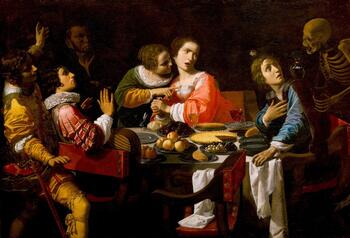
One of the first lines of prose that popped into my head after my diagnosis was “so much of my life has been spent being afraid of dying. With the time I have left, I endow not to die afraid.” This thought wakes me up in the morning. It looks at me when I look in the mirror. It lives in my sleep.
Yet it doesn’t mean I am passively acceptinga bathed-in-cancer passing. I have too much to live for, and so I bang metal with this scourge daily. I got a craniotomy. The creation of scars has commenced. I live with needles and insurance companies. I got a fitted, plastic Hannibal Lecter-ish mask complete with hockey mouth guard that will be used for pinpoint radiation treatment. So, when I use the affirmational words “endow not to die afraid”, it only means I can no longer fear the fear of death with the time I have left. I have given away way too many moments to the question “what if?” It makes for a lousy thought loop. All that ruminating about the prospect of death: acting hypochondriacally, the phobic tendencies, or more generally existing in a state of being in which the echoes of the past impose a filter on what I can do, what I can think, and what I can feel. And if brain cancer can afford me anything, it’s to let go of the bane that the “fear of death is more to be dreaded than death itself,” so notes Roman writer Publilius Syrus. Fear and acceptance, however, are mutually exclusive. I cannot effectively deal with my new reality without effectively dealing with the fear of it, and I cannot effectively deal with the fear of it without accepting in some measure that my time, this time, has come.
But acceptance is hard, especially of one’s mortality. It’s the ultimate master class to learn the ultimate truth. Yet it’s too often an exercise for only those who have been thrown to the spirits. Or those face-pressed to the fact of “memento mori”, translated as “remember you must die”. Many social interactions I have these days I am hard-pressed to not know that “death comes to the banquet table” In fact, I am that death. I am the skeleton others see when I go outside. I want to help change that perception of me, and of others battling incurable illness. But not for me, or for others like me. But for you. And when I say “you”, I mean “us”
First things first, when we talk about the fear of death, what are we talking about? The anthropologist Ernest Becker wrote: “This is the terror: to have emerged from nothing, to have a name, consciousness of self, deep inner feelings, an excruciating inner yearning for life and self-expression and with all this yet to die.” Is that what happens after death? I don’t know. You don’t know. And an A-list of thoughtful philosophers who have attempted to find out didn’t know either. But that’s not the point. The key, here, is not the veracity of the fear. Fear doesn’t need veracity. Rather, it’s the veracity of the fear’s impact. How does death anxiety live forward in the life of the individual? And how does what’s intrapersonal become the chorus of culture?
Before I got into the field of city building, I got a graduate degree in clinical psychology from Roosevelt University in Downtown Chicago. My thesis was on vicarious trauma related to the September 11th attacks, which turned into a series of published studies. The premise is that we live in a perilous world that’s constantly lighting the wick of a built-in bomb that is the self-awareness of our human condition, i.e., “memento mori”. But unless that awareness is forced up through aging, accidents, violence or illness on the individual level, or through war, terrorism, and pandemics on the collective level, then it’s buried like a bone in the backyard. That denial, then, is all too easily subsumed by the distractions that modern society affords. We plant our faces in our I-Phones. We gawk at 24-hour news cycles. We stream on devices. We got turned into tornadoes with every Trump tweet. But despite the gawking, the bone doesn’t go away. It lives through us. And the more that’s buried, the more that’s released. “Until you make the unconscious conscious, it will direct your life and you will call it fate,” explained the psychoanalyst Carl Jung.
Read the rest of this piece at RicheyPiiparinen.Medium.com.
Richey Piiparinen studies the life of Rust Belt cities at Cleveland State. Co-Founder, Rust Belt Analytica. Director, “Life After Rust”. Husband, father, Clevelander.
Photo credit: Infrogmation via Wikimedia under Public Domain, PD-Art.












